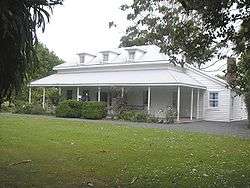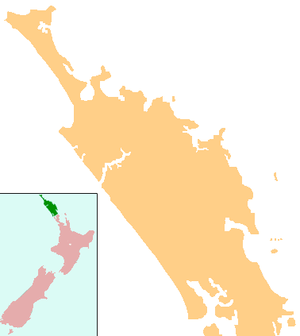Waimate North
Waimate North is a small settlement in Northland, New Zealand. It is situated between Kerikeri and Lake Omapere, west of the Bay of Islands.

Waimate North | |
|---|---|
 Waimate North | |
| Coordinates: 35°18′52″S 173°52′55″E | |
| Country | New Zealand |
| Region | Northland Region |
| District | Far North District |
It was one of the earliest centres of European settlement and features the second-oldest surviving European building in New Zealand, at Te Waimate mission.
History
Pre-European history
Okuratope Pā was situated here and was the home to chief Te Hotete (father of Hongi Hika) of the Ngai Tawake hapu in the late 18th-early 19th centuries. A major disturbance took place here in 1800, when an attacking Ngare Raumati war party from Te Rawhiti murdered and ate chief Te Maoi's wife, Te Auparo as well as their daughter, Te Karehu. This led to revenge attacks, which lasted over two decades; and resulted in the comprehensive defeat of the Ngare Raumati and the conquest of their lands by Ngapuhi (including Te Maoi and Te Auparo's three chiefly sons; Te Wharerahi, Rewa, and Moka 'Kainga-mataa'.
European settlement
Te Waimate Mission was the fourth mission station established in New Zealand, and the first settlement inland from the Bay of Islands.[1] The members of the Church Missionary Society (CMS) appointed to establish the mission were the Rev. William Yate and lay members Richard Davis, George Clarke and James Hamlin.[2]
The first European wedding in New Zealand was conducted on 11 October 1831 at the St John the Baptist church, when William Gilbert Puckey (26), son of a Missionary carpenter, William Puckey, married Matilda Elizabeth Davis (17), second daughter of the Missionary Rev. Richard Davis.[2][3]
During the Flagstaff War (1845-1846) casualties of the Battle of Ohaeawai were buried in the church yard of Church of St John the Baptist.[4] The mission station was used as the headquarters for the British army, after which the mission lost support among Māori.[4] The mission station gradually fell into disrepair and the buildings were subsequently put up for sale. Today the only remnant on the site is the house originally occupied by George Clarke, which is preserved by Heritage New Zealand as a museum.[5]
Modern history
The existing St John the Baptist church at Waimate North was built in 1871.[1][6]
Waimate North Christian School closed in 2005.[7]
Marae
The local Tauwhara Marae and Te Rangiawhiowhio meeting house is a traditional meeting ground for the Ngāpuhi hapū of Ngāi Tāwake, Ngāti Hineira, Ngāti Rēhia, Ngāti Tawake ki te Tuawhenua and Whānautara.[8][9]
References
- Bedggood, W.E. (1971). Brief History of St John Baptist Church Te Waimate. News, Kaikohe.
- "St. John the Baptist Church, Waimate North, Bay of Islands". Retrieved 27 December 2013.
- "Church of St John the Baptist (Anglican) and Churchyard (344 Te Ahu Ahu Road, Waimate North)". Retrieved 27 December 2013.
- "Church of St John the Baptist (Anglican) and Churchyard (344 Te Ahu Ahu Road, Waimate North)". Historic Places Trust. Retrieved 27 December 2013.
- "Te Waimate Mission House". Register of Historic Places. Heritage New Zealand. Retrieved 2009-12-01.
- "St. John the Baptist, Waimate North, Northland". Don Donovan.
- "Mergers, Closures and New Schools, January 2005 - December 2005" (XLS). Education Counts.
- "Te Kāhui Māngai directory". tkm.govt.nz. Te Puni Kōkiri.
- "Māori Maps". maorimaps.com. Te Potiki National Trust.